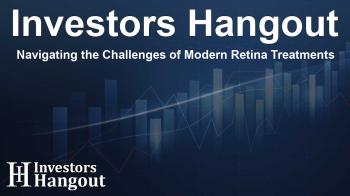Navigating the Challenges of Modern Retina Treatments

Understanding the Evolving Retina Treatment Landscape
The realm of treating neovascular age-related macular degeneration (nAMD) and diabetic macular edema (DME) is defining a crucial junction for healthcare providers and patients alike. Recent research sheds light on the competitive dynamics shaping the future of these critical therapies. As pressures mount from various fronts, including payers and the continuous evolution of gene therapies, ophthalmologists are finding themselves navigating a challenging landscape.
The Current Market Dynamics
Leading Treatments in Focus
In the latest updates from the ongoing RealTime Dynamix™ studies, Roche/Genentech's treatment, Vabysmo, has solidified its position at the forefront of retinal therapy. This drug is celebrated for its impressive efficacy and high levels of physician satisfaction, along with the flexibility it offers in dosing schedules. Meanwhile, Regeneron's Eylea HD is emerging as a strong contender, particularly among those who appreciate longer-lasting treatment options. Eylea 2mg continues to be a preferred choice in the second-line setting, favored for its track record of safety and effectiveness.
Challenges Presented by Biosimilars
The adoption of biosimilars in first-line treatment options remains limited despite the presence of interest among healthcare providers. Many are hesitant to embrace these alternatives fully, citing clinical conservatism and questions surrounding their interchangeability. Nevertheless, the landscape might shift as payers increasingly determine treatment pathways and limit access to branded biologics unless patients first trial biosimilars.
The Influence of Payer Policies
Impact on Patient Care
Payer policies are exerting a powerful influence over treatment choices. A significant number of physicians report that factors like coverage restrictions and authorization requirements are impacting their decisions. There is a growing concern among practitioners that nearly 33% of patients may not receive optimal care due to these barriers. Many practices are adapting by employing dedicated biologic coordinators to manage these administrative complexities, yet prior authorization issues continue to create significant delays. The rise of AI systems designed to assist in denials is further complicating the landscape, introducing inefficiencies and affecting how soon patients can receive their desired therapies.
Looking Ahead: The Promise of Gene Therapies
Pioneering Innovation on the Horizon
Amidst this turbulent backdrop, the emergence of gene therapies paints an optimistic future. Ophthalmologists are ripe with anticipation regarding new therapies currently in development, such as 4DMT's 4D-150, AbbVie's ABBV-RGX-314, and Adverum's Ixo-vec, which promise to alleviate the treatment burden significantly. With their potential to redefine the current treatment paradigm, many experts predict a transformative shift within the retina treatment landscape. As we look toward the future, over 70% of ophthalmologists expect that the treatment options available will evolve drastically within the next several years.
Continued Insights from Spherix Global Insights
As one of the foremost independent advisory firms focused on market intelligence, Spherix Global Insights is committed to continually tracking these shifts in the retinal therapy landscape. Their recent survey involving responses from 112 U.S. ophthalmologists underscores the urgency for stakeholders to engage with ongoing developments. By delivering up-to-date insights, Spherix aims to help key players adapt and succeed in an environment constantly shaped by innovation and payer dynamics.
Frequently Asked Questions
What is the focus of the recent Spherix Global Insights research?
The research centers on the treatment landscape for nAMD and DME, examining prescribing dynamics and the impact of payer pressures on treatment options.
Which treatments are currently leading in the retina market?
Roche/Genentech's Vabysmo leads the market, followed closely by Regeneron's Eylea HD and Eylea 2mg in second-line use.
How are biosimilars perceived by ophthalmologists?
While there is some interest in biosimilars, their uptake remains limited due to concerns about efficacy and safety, along with payer restrictions.
What challenges do ophthalmologists face with payer policies?
Payer policies significantly affect treatment decisions due to restrictions, prior authorization requirements, and related administrative burdens.
What promises do emerging gene therapies hold?
Gene therapies like 4D-150 and ABBV-RGX-314 offer hope for reducing treatment burdens and could redefine the standard of care within the next few years.
About The Author
Contact Addison Perry privately here. Or send an email with ATTN: Addison Perry as the subject to contact@investorshangout.com.
About Investors Hangout
Investors Hangout is a leading online stock forum for financial discussion and learning, offering a wide range of free tools and resources. It draws in traders of all levels, who exchange market knowledge, investigate trading tactics, and keep an eye on industry developments in real time. Featuring financial articles, stock message boards, quotes, charts, company profiles, and live news updates. Through cooperative learning and a wealth of informational resources, it helps users from novices creating their first portfolios to experts honing their techniques. Join Investors Hangout today: https://investorshangout.com/
The content of this article is based on factual, publicly available information and does not represent legal, financial, or investment advice. Investors Hangout does not offer financial advice, and the author is not a licensed financial advisor. Consult a qualified advisor before making any financial or investment decisions based on this article. This article should not be considered advice to purchase, sell, or hold any securities or other investments. If any of the material provided here is inaccurate, please contact us for corrections.

